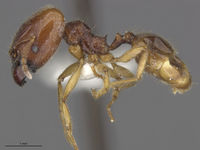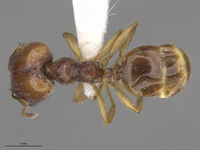Pheidole hispaniolae
| Pheidole hispaniolae | |
|---|---|
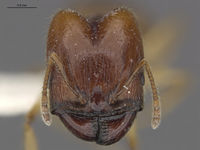
| |
| Scientific classification | |
| Kingdom: | Animalia |
| Phylum: | Arthropoda |
| Class: | Insecta |
| Order: | Hymenoptera |
| Family: | Formicidae |
| Subfamily: | Myrmicinae |
| Tribe: | Attini |
| Genus: | Pheidole |
| Species: | P. hispaniolae |
| Binomial name | |
| Pheidole hispaniolae Wilson, 2003 | |
The type colony was found in a rotting log in second-growth mountain rainforest. Other colonies were found in pine and mixed pine-hardwood forests. One nest contained males when discovered in April. (Wilson 2003)
Identification
See the description in the nomenclature section.
Keys including this Species
Distribution
Known from the type locality and other sites at 1100–1500 m in the Dominican Republic. (Wilson 2003)
Latitudinal Distribution Pattern
Latitudinal Range: 19.04166667° to 18.84354°.
| North Temperate |
North Subtropical |
Tropical | South Subtropical |
South Temperate |
- Source: AntMaps
Distribution based on Regional Taxon Lists
Neotropical Region: Dominican Republic (type locality), Greater Antilles.
Distribution based on AntMaps
Distribution based on AntWeb specimens
Check data from AntWeb
Countries Occupied
| Number of countries occupied by this species based on AntWiki Regional Taxon Lists. In general, fewer countries occupied indicates a narrower range, while more countries indicates a more widespread species. |

|
Estimated Abundance
| Relative abundance based on number of AntMaps records per species (this species within the purple bar). Fewer records (to the left) indicates a less abundant/encountered species while more records (to the right) indicates more abundant/encountered species. |

|
Biology
Castes
Worker
minor
 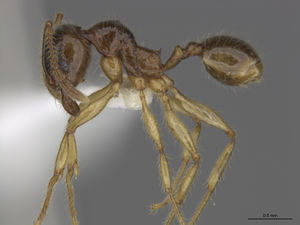 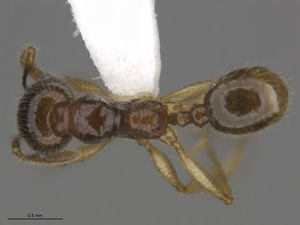 
| |
| . | |
Nomenclature
The following information is derived from Barry Bolton's Online Catalogue of the Ants of the World.
- hispaniolae. Pheidole hispaniolae Wilson, 2003: 707, figs. (s.w.) DOMINICAN REPUBLIC.
Unless otherwise noted the text for the remainder of this section is reported from the publication that includes the original description.
Description
DIAGNOSIS Similar in various traits to Pheidole balzani, Pheidole brunnescens, Pheidole exarata, Pheidole excubitor, Pheidole fabricator, Pheidole germaini, Pheidole nigella, Pheidole prattorum, Pheidole sabina, Pheidole sarpedon, Pheidole tristis, Pheidole tristops and Pheidole unicornis, differing as follows.
Major: head subquadrate, with gently convex sides and deep occipital cleft; promesonotal profile flat; propodeal spines thin, almost needle-like; petiolar node in side view tapered to a blunt point; postpetiolar node 2X broader than petiolar node in dorsal view, and cone-shaped; posterior third of dorsal head surface smooth and mostly shiny, sprinkled with widely spaced foveae; no rugoreticulum present anywhere; promesonotum carinulate.
Minor: occiput broad, lacking nuchal collar; humeri dentate; promesonotal profile smoothly semicircular; promesonotum partially carinulate; most of body smooth and shiny.
MEASUREMENTS (mm) Holotype major: HW 1.64, HL 1.86, SL 0.86, EL 0.20, PW 0.78. Paratype minor: HW 0.66, HL 0.74, SL 0.78, EL 0.14, PW 0.46.
COLOR Major: body light reddish brown, mandibles medium reddish brown, legs plain medium yellow.
Minor: light to medium brownish yellow, legs plain medium yellow.
Figure. Upper: holotype, major. Lower: paratype, minor. Scale bars = 1 mm.
Type Material
DOMINICAN REPUBLIC: 14 km northwest of Bonao, 19°02'N 70°30'W, 1100 m, col. Philip S. Ward. Museum of Comparative Zoology
Etymology
Named after the Greater Antillean island of origin.
References
- Wilson, E. O. 2003. Pheidole in the New World: A dominant, hyperdiverse ant genus. Harvard University Press, Cambridge, MA. (page 707, fig. major, minor described)
- Lubertazzi, D. 2019. The ants of Hispaniola. Bulletin of the Museum of Comparative Zoology, 162(2), 59-210 (doi:10.3099/mcz-43.1).
References based on Global Ant Biodiversity Informatics
- Perez-Gelabert D. E. 2008. Arthropods of Hispaniola (Dominican Republic and Haiti): A checklist and bibliography. Zootaxa 1831:1-530.
